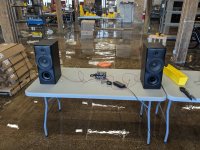I did post them. Though I admit that I have two threads going on it now.
What I don't understand is why REW summation of the nearfield of the woofer and port do not match the VCAD sim. Here are the two against one another. The VCAD using the merger tool with baffle step applied to the low end.
I suppose I will see soon which is right when I take the measurement of the completed system.
What I don't understand is why REW summation of the nearfield of the woofer and port do not match the VCAD sim. Here are the two against one another. The VCAD using the merger tool with baffle step applied to the low end.
I suppose I will see soon which is right when I take the measurement of the completed system.
Attachments
Perhaps I wasn't clear enough, the image I posted was a screenshot from the Vituix manual and none of the information in it refers to your situation or driver, it was to show an example of what the combination process would generally look like when done properly.I went ahead a aligned the sum, applying the baffle step to the low end properly with the Sd of the woofer and the port respectively.
This should be what it looks like, same conclusion as you almost.
It did not affect anything near the XO point so I think cutting the corner was acceptable. VituixCad is basically a mirror image of the WinISD sim. This is a good sign for the system.
One question though: why did you set Sd of the silver flute to 75? On madisound it has the 6.5" as 132. The port is 2" in diameter and by my calculation that comes out 20 cm2. Am I using the wrong calculation here?
As I said before your port output looks somewhat unexpected to me. Ports are most often tuned with a reasonably high Q and have that triangular shape to the output.
Your measurement shows a very spread out port output. This could be an incorrect measurement or it could be real. If it is real it would suggest quite a bit of resistance somewhere in the port to damp the Q and spread the port out.
I would personally not take any shortcuts with speaker measurements. They are surprisingly easy to get wrong in some way and that can have a knock on effect to the decisions made in the design. Put all the separate measurements into Vituix and let it do the merge and diffraction simulation, it is easier to see how any change affects the whole response.
The last combined output looks much more realistic but I still have doubts that it is right. I would look at how you measured the port and try again to see if you still get the same result. Ports are a relatively well understood area of acoustics and the modelling is usually pretty good if the input isn't far off.
If what you measure isn't similar to what winisd or Vituix predicts it is good to find out why.
A speaker design is not just about crossing the drivers but controlling the overall frequency response over the whole range. Getting the baffle step compensation right and the overall tonality is a really big part of making a speaker that does not suck. I get that this is a cheap and simple project but it can be a good learning experience to see what you can get out of the parts you have.
Fluid,
Honestly, I was also surprised at the port output. I used the same method of measurements I used on my last 3 way for this build. The 3 way model measured out nearly exactly to the sim on the low end so I don't see why this would be any different. Soon there will be a real world measurement which I am excited to see
Honestly, I was also surprised at the port output. I used the same method of measurements I used on my last 3 way for this build. The 3 way model measured out nearly exactly to the sim on the low end so I don't see why this would be any different. Soon there will be a real world measurement which I am excited to see
Wow!! Beauties!Annnndddd we're done!
Very nice!
- Home
- Loudspeakers
- Multi-Way
- A boring 2 way build





